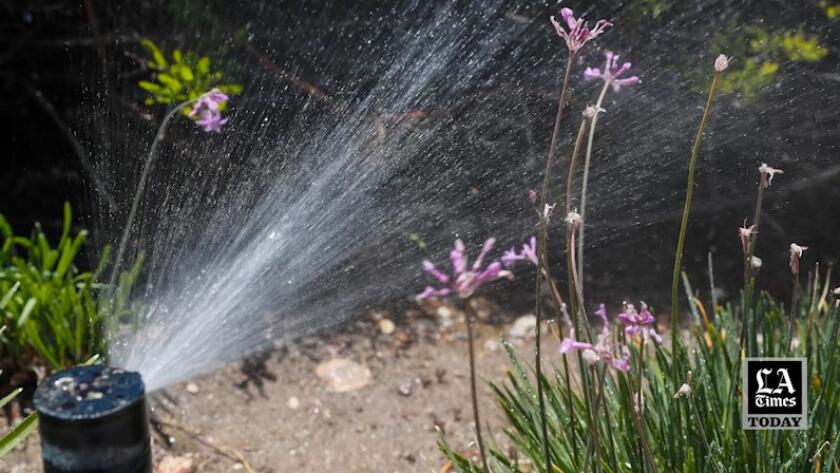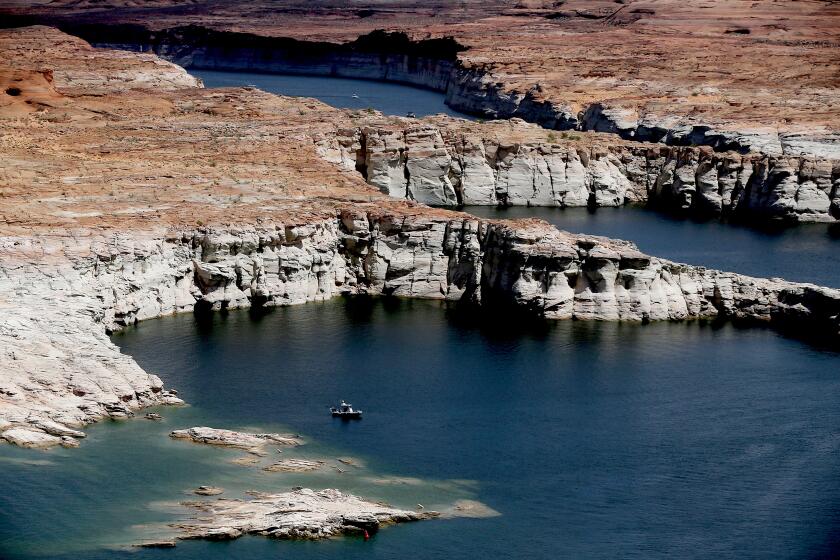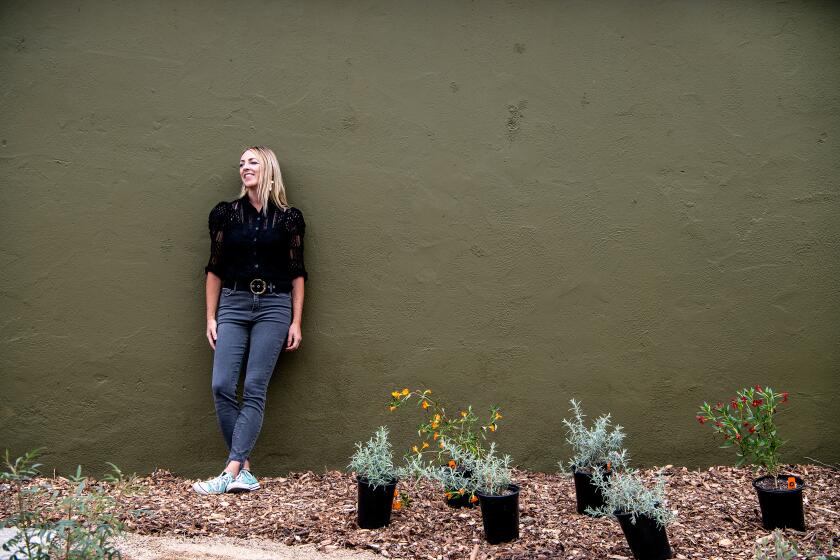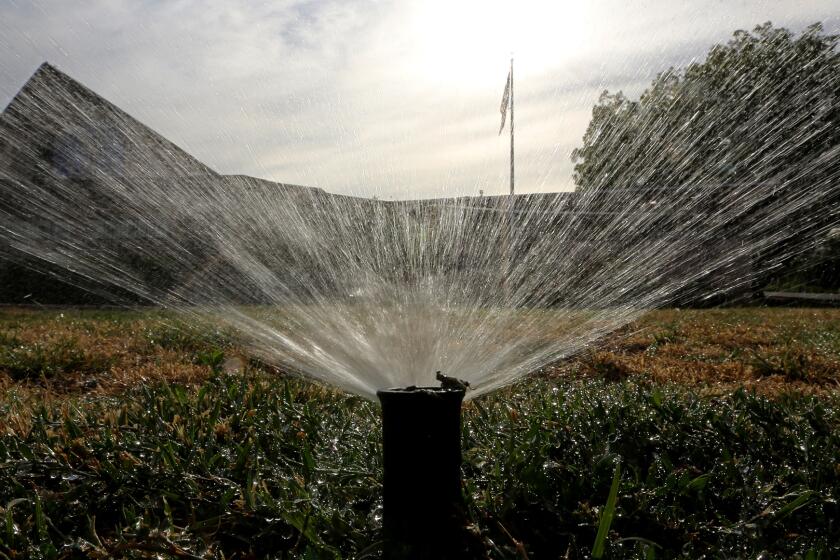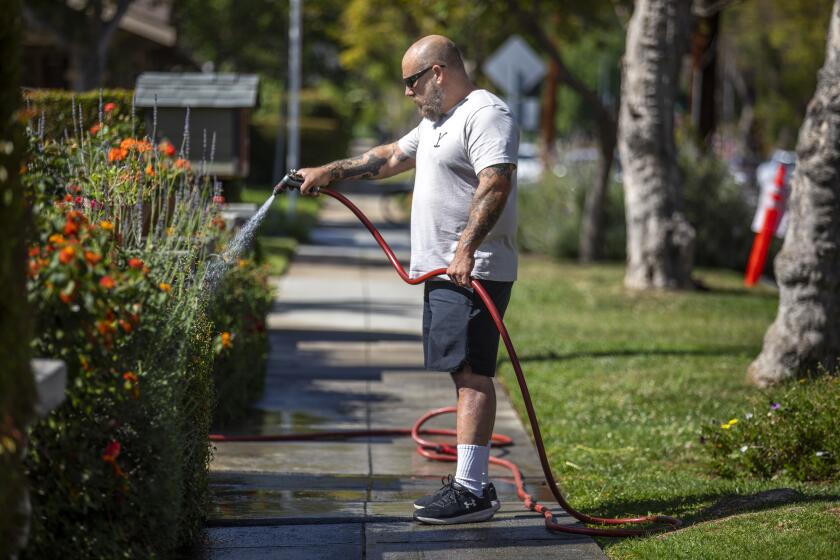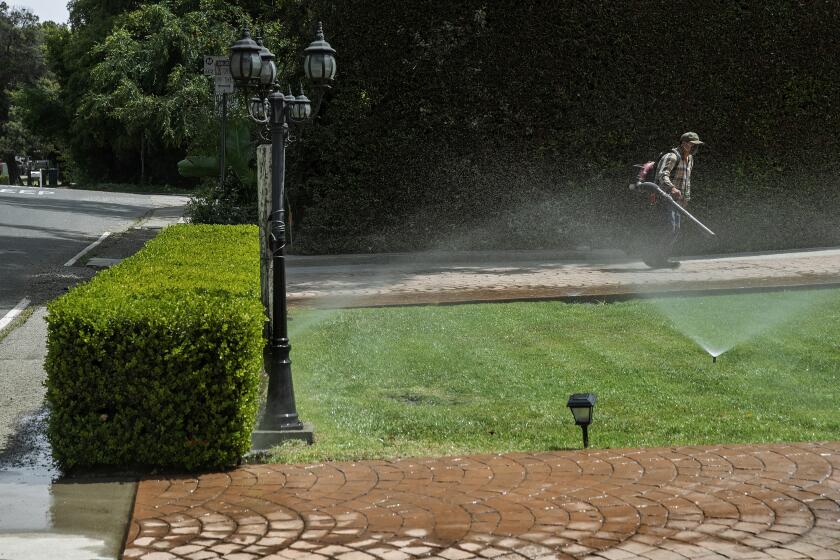One way around California’s water restrictions: Recycle water from your laundry

- Share via
Despite years of drought and conservation mandates, Californians continue to sprinkle a lot of clean, drinkable water onto yards to keep the greenery alive. That’s true even on properties that have scaled back thirsty lawns and added drought-tolerant native plants.
Now, however, Southern California officials have imposed unusually strict limits on outdoor water use in response to a water shortage emergency, effective June 1. So you may need to find an alternative way to keep your plants from desiccating in the summer sun.
How about irrigating them with grey water instead of sprinkling them with clean water?
Grey water is the water from faucets, showers, bathtubs, washing machines — anything that’s not laden with human waste, food or toxic chemicals. Which is not to suggest that it’s clean — it’s infused with soap and related chemicals (such as nitrogen and phosphorus), dirt, lint and other stuff you wouldn’t want to drink or put into the ocean. Nor would you want to store untreated grey water, which quickly turns fetid. But with the right setup and precautions, grey water can be fine for most plant life.
If you’re a typical Southern Californian, you’re dumping a lot of grey water into the sewer system. Every load of clothes you wash generates roughly 15 to 40 gallons of it, depending on your washer’s design and efficiency. Over the course of a year, that’s thousands of gallons of soapy water flushed.
- Share via
Watch L.A. Times Today at 7 p.m. on Spectrum News 1 on Channel 1 or live stream on the Spectrum News App. Palos Verdes Peninsula and Orange County viewers can watch on Cox Systems on channel 99.
That’s enough to keep a number of trees, shrubs and other plants happy. And if you’re really ambitious, you can build a system that pipes all of your home’s grey water to the roots of your lawn, although a big yard of nonnative grasses may need more water than your house can supply.
These projects can be straightforward, but they’re not as simple as installing a new faucet or planting a garden. You’ll probably need help, even for a project that doesn’t require a city permit.
Some critics, notably the Los Angeles Sanitation and Environment Bureau, see grey water recycling as environmentally risky, damaging to public wastewater recycling efforts and uneconomic. Meanwhile, other local agencies across the state, including the Los Angeles Department of Water and Power, actively promote grey water projects as a way to reduce water use.
Advocates admit that the projects carry some risk and require diligence, but insist that they can save clean water and help your plants. Here are a few things to consider when exploring a shift to grey water.
Citing extreme drought, the government has announced reduced water releases from Lake Powell and Glen Canyon Dam by nearly half a million acre-feet.
What does a grey water system involve?
Grey water is a no-no for surface watering. So prepare to build a new irrigation system.
Unlike the water supplied by your local utility, grey water is rich in chemicals that feed microbes, so it cannot be allowed to flow into the gutters and storm sewer (which, in the Los Angeles basin, drains into the ocean). Nor do you want it pooling in your yard, where it would provide a breeding ground for mosquitos.
Instead, it will need to travel across your property through a set of pipes separate from the ones you’ve been using for your sprinklers or drip irrigation lines.
The new pipes will have to discharge at least 2 inches underground, typically into a small basin or trench filled with mulch. That keeps the water off the surface and filters it on its way to the roots of your plants. You’ll need to shield each outlet of the pipe from debris to prevent clogging.
Rather than delivering the water according to a schedule, grey water is typically meted out as it’s produced or within 24 hours of its collection.
This isn’t like rainwater, which you can collect in a cistern and use whenever you like. Even if you add a storage tank to your grey water system, it can’t hold the water for more than a day. That’s because the water can rapidly turn smelly as the skin, hair and other contaminants it contains degrade.
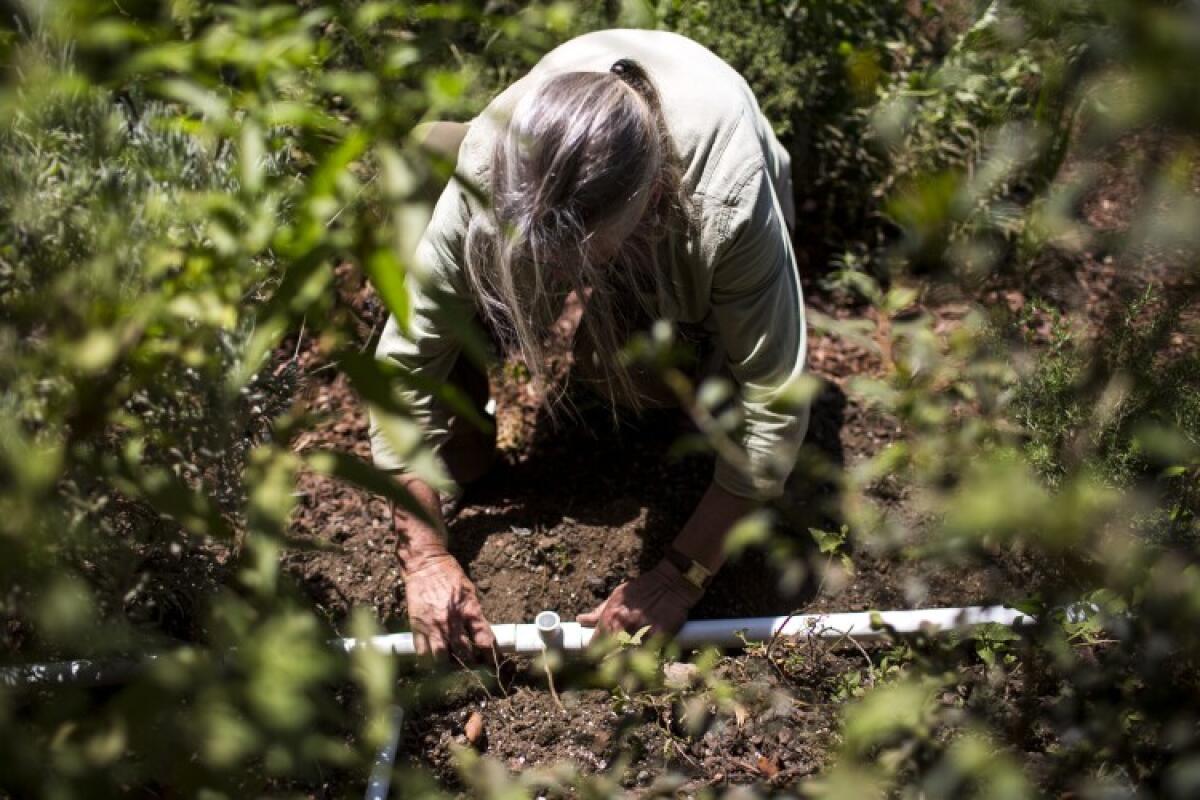
Granted, the technology exists to treat grey water so it can be stored for longer periods and used for surface watering, among other things. But in Los Angeles, on-site treatment and reuse is not yet allowed “due to lack of approved standards,” according to the L.A. Department of Water and Power. It’s not clear when those standards might be adopted. The National Sanitation Foundation adopted a standard in 2011 for on-site treatment and reuse, but only for systems much larger than the kind a homeowner might use.
The least-complicated grey water system relies on gravity to distribute the water pumped out by a washing machine, while larger systems with storage tanks have their own pumps. Either way, the system will need a valve that can direct grey water into the sewer when it’s not needed in the yard, when you’re cleaning diapers or when you’re putting bleach into your wash load. You may also want to add a vent to the system to speed the flow of grey water to your yard.
The pipes, valves and other materials for the most basic grey water system will cost about $200, said Laura Allen, co-founder of the educational group Greywater Action. If you hire someone to do the work, she said, expect the job to take about a day and cost about $2,000, although your cost will depend on what lies between your washer and the plants you’re going to water. Running a pipe under a driveway or concrete porch is a lot more expensive than running one across a yard.
In Los Angeles, the city Department of Building and Safety has tried to simplify the process of adding a basic, gravity-based system to your yard by providing instructions and a standard plan on its website. You can submit the planning form online to the department’s ePlanLA portal or in person.
“We wanted to make it really simple,” said Osama Younan, the department’s general manager. “You bring it in; you walk out with a permit.”
Younan said homeowners’ interest in laundry-to-landscape systems surged during the last drought emergency, then dropped off. He expects that the new emergency and tight restrictions on outdoor water use will spur another wave of projects.
Southern California officials have declared a water shortage emergency. Here’s how to keep home and garden dreams alive while still restricting water usage.
Should I install one?
Allen listed three issues to consider.
Is your property suitable?
If you’re going with a basic laundry-to-landscape system, Allen said, you’ll need to move the grey water directly from your washing machine to the plants. So your washing machine will have to be within reach of an exterior wall or a crawlspace, and the route to the plants will need to be level or on a downslope. Greywater Action advises that to avoid overtaxing your washer’s built-in pump, avoid piping grey water more than 50 feet.
Any system that requires a pump also requires a permit from local authorities, which inevitably adds time and expense to the job. Greywater Action estimates that a pumped system can be twice as expensive as a basic one that relies on gravity.
Do you have the right kinds of plants?
The best targets for grey water irrigation, Allen said, are “larger structural plants” such as trees, bushes and shrubs. One 4-foot-wide shrub could consume 12 gallons a week, which represents about one load of laundry, Allen said.
One important thing to keep in mind: Grey water is not for anything edible grown on or under the ground. It may also be a poor fit for plants that respond badly to water that has more salts and a higher pH than rainwater, such as fruit trees. Some detergents contain boron, which is toxic to plants; bleach also makes soil less healthy. But Allen said you can address these issues by looking for detergents that are billed as safe for plants.
How much of your current system do you want to replace?
To irrigate a lawn would require a significant amount of grey water — typically more than just a washing machine’s drainage. That means a more advanced (and costly) system to collect all of a home’s grey water and filter out the debris before pumping it to a new set of pipes under the lawn, she said.
A whole-home system might be a good approach if you’re building a new house or replacing the plumbing, and if you’re willing to tear out your lawn and replant it. But there’s one more complication: To avoid ruinous clogging, the filter would have to be cleaned regularly. The most reliable way to do that, Allen said, is with a filter that’s automatically cleaned with water from the local utility. But that involves extra engineering to avoid your grey water seeping into the potable water system.
On the plus side, a more complex system would yield more savings. Using the DWP’s estimates, replacing city water with grey water in Los Angeles could save a family of four more than $220 per year with a basic laundry-to-landscape system and more than $580 per year with a whole-house set-up. Your savings will depend on your water use.
Californians are well-acquainted with the need to save water. Here are some practical tips to cut your water use, plus a look at the big picture.
What do critics say?
One of the most common concerns is the effect grey water can have on soil, plants and the irrigation networks that carry it.
Many types of detergent have salts and boron that can build up in soil, making it less fertile and even damaging to some kinds of plants. And poorly designed or maintained systems can become clogged — to the detriment of your washing machine — and smelly. So if you’re going to recycle grey water, you’ll need to use plant-friendly soaps and detergents, keep toxic chemicals out of the laundry, design it thoughtfully and be diligent about maintenance (more on that later).
But not everyone will follow all the rules, said Ali Poosti, interim manager of L.A. Sanitation’s wastewater engineering services division. “Who is really going to enforce that and inspect that and make sure the system is going to operate as it should?” he asked. And once the chemicals and microplastics in grey water get into the soil, he said, they can find their way into the groundwater that provides part of L.A.’s water supply.
That’s just one of the reasons L.A. Sanitation officials are no fans of residential grey water projects. Another is the concern that diverting grey water away from sewers will slow down the flow of solid waste through the system, damaging the pipes and increasing odors. The division is also skeptical that grey water projects save water. In a 2015 report, it pointed to a pilot program in 2013 in Long Beach that saw a slight increase in water use among most homes that installed laundry-to-landscape systems.
The studies cited in the report, however, show conflicting results on all of those issues. For example, the report noted a 2013 paper by Allen and colleagues that looked at 83 residential grey water systems in the Bay Area and found no negative effects on plants and an average decrease in water consumption of 17 gallons per day.
Perhaps the biggest complaint from L.A. Sanitation is that home grey water systems decrease the amount of water available for the city’s wastewater treatment and recycling efforts. Los Angeles is betting heavily on wastewater recycling, Poosti said, with projects in development across the city.
“You serve a lot more people if you have a holistic system in place than individual projects,” he said.
Finding your favorite nursery can be thrilling. Here are our picks for the best independently owned plant nurseries near Los Angeles.
What kind of system makes sense for me?
The first question you should ask is how much of your current system you want to replace, because that’s going to determine the scale, complexity and cost of your project.
But you don’t want to set a goal you can’t achieve, right? So it helps to know how much grey water your washer, tub, shower and bathroom sinks produce, as well as how much water your plants need.
It’s hard to come up with precise answers to those questions. To judge how much grey water you’d get from your washer, check the estimates on the Energy Star site for your model. Your results will vary, depending on how many loads you wash per week and, for front-loading machines, how much you stuff in per load.
To estimate the maximum amount of grey water you could get from your house, the Home Water Works site has a calculator, although you’d have to subtract the amounts associated with toilets, dishwasher and leaks. Or you could look at your water bill and then do a very rough calculation based on research showing that a little less than half of the typical home’s water use is indoors, and of that amount, close to 60% is from grey water sources.
As for calculating your plants’ requirements, the place to start is by cataloging what you have in your yard. Your plants’ thirst will depend on their size, the type of soil you have, what part of California you’re in and other variables.
To get a good idea, you can use an index of plants and their needs developed by the UC Cooperative Extension and the companion How Much Water? app developed by irrigation designer Lori Palmquist. And for some ideas about what native plants to use in your yard, the California Native Plant Society offers a list online that’s specific to your address.
The L.A. DWP offers a formula to calculate how much yard you can irrigate with the grey water you generate. By its estimate, a laundry-to-landscape system produces 105 gallons per person per week, and a whole-house system produces 280 gallons per person. But your results will vary, depending on how efficient your washer and your fixtures are.
Unprecedented cuts in water use will require sacrifices for Southern California.
Can I build a grey water system myself?
It depends on how comfortable you are drilling larger-than-usual holes in your house. Even a basic, no-permit-required setup will involve running a 1-inch or wider pipe from your washing machine to a new irrigation system outdoors.
Allen put it this way: “It’s for DIYers who take on irrigation projects.” If you’ve installed a drip irrigation system in your yard or replaced a window in your house, she said, you can build a basic grey water set-up.
Greywater Action provides detailed examples of different types of systems to guide you. The DWP also offers a number of pointers on installing and operating a greywater system.
The state’s plumbing code dictates aspects of a grey water system’s layout, including required distances from buildings, property lines, wells, water service pipes and water mains. It also specifies testing and inspection requirements, as well as suggesting how the systems should be maintained.
Oh, yes — don’t forget maintenance. The DWP recommends inspecting the components of your system and the subsurface water outlets every week, and the soil around the plants you’re watering every month, to make sure things keep working as intended. If you have a filter, DWP recommends cleaning it weekly to prevent clogging, then replacing it as required by the manufacturer.
Areas that get water from the Colorado River or other sources will be spared from restrictions, at least for now. The strategy has divided experts.
Additional reading:
- L.A. DWP’s grey water site.
- Oasis Design’s common errors and best practices page.
- Greywater Action’s rundown of California regulations and answers to frequently asked questions.
- The Los Angeles Department of Building and Services’ grey water systems page, which outlines the city’s requirements for permitted and nonpermitted systems.
- Complete coverage of the California drought from the L.A. Times.
About The Times Utility Journalism Team
This article is from The Times’ Utility Journalism Team. Our mission is to be essential to the lives of Southern Californians by publishing information that solves problems, answers questions and helps with decision making. We serve audiences in and around Los Angeles — including current Times subscribers and diverse communities that haven’t historically had their needs met by our coverage.
How can we be useful to you and your community? Email utility (at) latimes.com or one of our journalists: Jon Healey, Ada Tseng, Jessica Roy and Karen Garcia.
